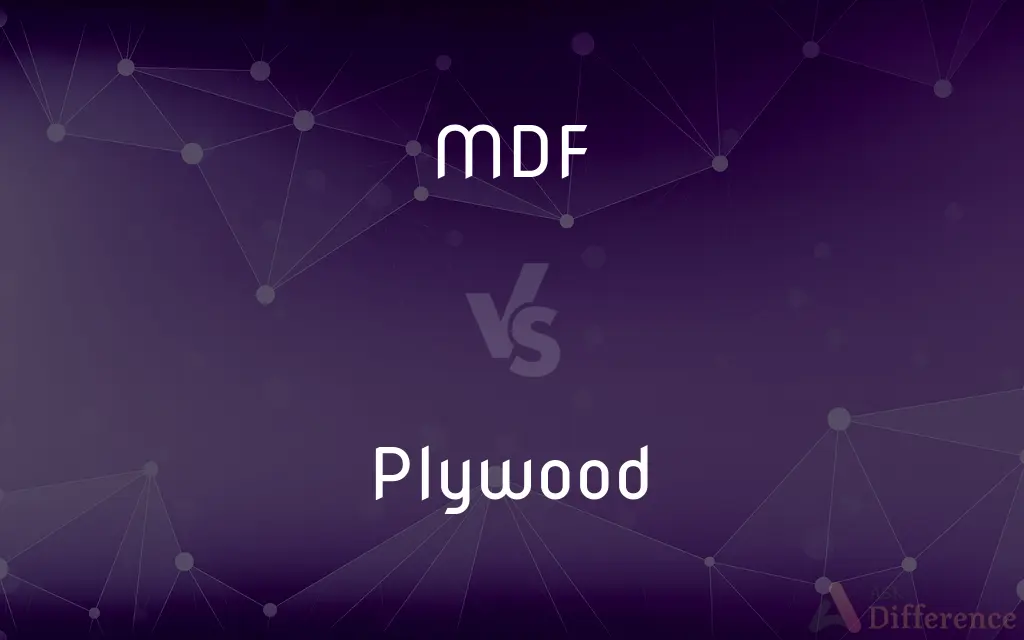MDF vs. Plywood — What's the Difference?
By Tayyaba Rehman — Published on October 28, 2023
MDF (Medium Density Fiberboard) is a wood product made from glued wood fibers, while Plywood consists of multiple thin layers of wood veneer bonded together.

Difference Between MDF and Plywood
Table of Contents
ADVERTISEMENT
Key Differences
MDF and Plywood are both commonly used in the world of woodworking and construction. MDF, or Medium Density Fiberboard, is a type of engineered wood product that's made by breaking down softwood or hardwood residuals into fibers, which are then combined with wax and a resin binder. This mix is formed into panels by applying high temperature and pressure. On the other hand, Plywood is made by gluing together several thin layers, or 'plies,' of wood veneer.
While MDF is generally smoother because it doesn't contain knots like natural wood, Plywood tends to be stronger due to its laminated structure. Plywood's strength is enhanced by alternating the grain of each layer, making it less prone to warping. MDF, with its dense and even texture, offers an ideal surface for veneering or painting because of its smoothness.
Durability-wise, Plywood typically has an edge over MDF in environments where moisture is present. MDF can swell or deform if exposed to substantial moisture, while Plywood, especially types designed for outdoor use, can resist moisture better. It's crucial, however, to note that not all Plywood types are moisture-resistant.
In terms of weight, MDF is usually heavier than Plywood. This can be a factor when considering ease of transport and installation. Conversely, Plywood, with its layered construction, often provides better screw-holding capability than MDF.
Comparison Chart
Composition
Glued wood fibers
Multiple layers of wood veneer bonded together
ADVERTISEMENT
Texture
Smooth, without knots
May contain knots, varies with veneer type
Resistance to Moisture
Can swell with significant moisture
Some types resist moisture better than others
Weight
Generally heavier
Lighter than MDF, but varies with type and thickness
Screw-Holding Capability
Can be weaker
Generally better due to layered construction
Compare with Definitions
MDF
MDF is created from wood fibers.
MDF production involves breaking down wood into fibers, then forming panels.
Plywood
Plywood can resist moisture.
For outdoor projects, she opted for a moisture-resistant Plywood.
MDF
MDF is heavier than many woods.
Transporting the MDF board required additional help due to its weight.
Plywood
Plywood has a laminated structure.
The alternating grain in Plywood's layers prevents warping.
MDF
MDF has a dense, even texture.
She preferred MDF for painted projects because of its consistency.
Plywood
Plywood offers better screw retention.
He chose Plywood for the shelves due to its strong screw-holding capacity.
MDF
MDF is an engineered wood product.
For his project, he chose MDF because of its smooth texture.
Plywood
Plywood is made from layers of wood veneer.
He chose Plywood for its strength and layered structure.
MDF
MDF can be sensitive to moisture.
After a water leak, the MDF cabinets swelled and deformed.
Plywood
Plywood varies based on its veneer type.
The quality of Plywood depends on the type of wood veneer used.
Plywood
A structural material made of layers of wood glued together, usually with the grains of adjoining layers at right angles to each other.
Plywood
(uncountable) Construction material supplied in sheets, and made of three or more layers of wood veneer glued together, laid up with alternating layers having their grain perpendicular to each other.
After the hurricane there was a severe regional shortage of plywood, especially exterior plywood.
Plywood
(countable) A specific grade or type of this construction material.
We stock exterior plywoods, interior plywoods, and furniture plywoods.
Plywood
(transitive) To fit or block up with plywood.
Plywood
A laminate made of thin layers of wood
Common Curiosities
Which is smoother, MDF or Plywood?
MDF is generally smoother than Plywood.
Can MDF be used in damp environments?
MDF can deform in moisture-rich settings, so it's less suitable for such environments.
Why choose MDF over Plywood or vice versa?
The choice depends on the project's requirements, such as moisture resistance, strength, or finish.
Is Plywood always moisture-resistant?
Not always. Some Plywood types are designed for outdoor use and resist moisture better.
Are MDF and Plywood the same?
No, MDF is an engineered wood product, while Plywood consists of layers of wood veneer.
Which is more versatile for finishes, MDF or Plywood?
MDF offers a smoother surface for veneering or painting, while Plywood is versatile based on veneer type.
Which is more expensive, MDF or Plywood?
Costs vary based on quality and type, but Plywood can be more expensive than MDF.
Is Plywood stronger than MDF?
Yes, Plywood usually offers more strength due to its laminated structure.
Can both MDF and Plywood be painted?
Yes, both can be painted, but MDF offers a smoother surface for paint.
Why is Plywood stronger?
Plywood's strength comes from its laminated structure with alternating grain patterns in each layer.
Share Your Discovery

Previous Comparison
Letter of Credit vs. Line of Credit
Next Comparison
Marines vs. Navy SEALsAuthor Spotlight
Written by
Tayyaba RehmanTayyaba Rehman is a distinguished writer, currently serving as a primary contributor to askdifference.com. As a researcher in semantics and etymology, Tayyaba's passion for the complexity of languages and their distinctions has found a perfect home on the platform. Tayyaba delves into the intricacies of language, distinguishing between commonly confused words and phrases, thereby providing clarity for readers worldwide.













































